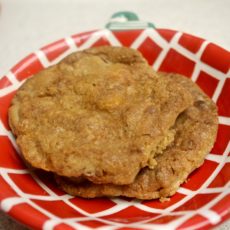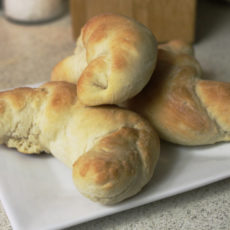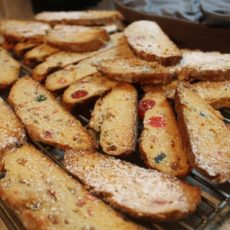Here’s one I’ve made a couple of times before. 17-38: Olive Bread is a nice, easy bread to make, especially if you don’t have a ton of experience with the process. I think sometimes yeast doughs can be intimidating to beginners, but this one hasn’t failed me yet–even when I was still just beginning to make bread. If you’re looking for a more “plain” type easy bread, check out 17-6: Best Ever White Bread. However, if you like those olive batard breads from the bakery section of the market, you’ll love this one.

I’ve made this twice before, once in its intended form (but with more olives because I LOVE olives) and again soon after, but in a smaller bun-size with chipotle peppers & garlic instead of olives. I used them for slider buns for burgers intended for a New Years’ party, judging from the date on the card. What will I change about this recipe this time?

There’s some blurry (bad pen + moisture) notes of mine on the front and back of this card. I think the notes from the first time are probably the more relevant ones–I’d definitely suggest doubling (or more) the olives you use in this bread if you enjoy olives like I do. Don’t like olives? Swap in something else if it makes you happy.

Ingredients. There’s not a lot to this recipe–the type of olives and herbs you use are probably where you want to make your tweaks. I chose pitted kalamata olives for this incarnation, which I think have a better flavor for bread than regular black olives. For herbs, I went with herbes de Provence, mostly because I love it and use it whenever I can (it’s great on grilled meats, if you’re looking for another use for it).

Dissolving the yeast in the warm water. I usually buy yeast from the bulk bins (storing most of the excess in the freezer to keep it fresh), so I’ll save you the search: it’s 2 1/4 teaspoons of yeast in a package. Yeast will be less effective after a while (baking soda too), so make sure you’re using relatively fresh stuff. With both, if they’re too old your stuff won’t rise well.
You can use a thermometer (probably a candy one) if you want to be precise with your water temperature, but neither professional pastry chef I worked with ever used one, and we used yeast every day. Basically, around the temperature of the warm water you’d wash your hands under is about where you’d want to be–not hot enough to be uncomfortable, but warm enough to activate the yeast. You want to wake them up, not kill them.

I like the taste of olive oil in savory bread dough–my favorite pizza dough recipe from Serious Eats uses it and I make it at work every few weeks with great results. With olives in the bread, it only makes sense to use olive oil (as opposed to like, canola, which some breads use).

Count on needing to use all the flour the recipe recommends, if not even a bit more. I probably needed to add more to counteract the moisture from the additional olives I added. Covered the bowl with a towel and placed it on top of the refrigerator (a nice, draft-free, warm place) to rise.

The two pictures look the same, but it did get a bit bigger. I probably could have punched it down and let it rise a few more times (we used to do three rounds of punch downs/rises on the bread we made for the restaurant) to get even more lift, but this’ll do. Remember, you’ll get some oven spring too.

The recipe suggests you make these into rounds. I had every intention of making them into rounds–I started by splitting it into 8 pieces as recommended. Rolling it out into a circle and cutting it like a pizza seemed like the easy way to get 8 even pieces, so I did that and started to form the first few pieces into balls. I then realized that they were in the perfect shape to make them into crescents instead–so I did. I’ve done the rounds before, and I thought these might make interesting crescent rolls.

I put my 8 crescents (start at the big end of the triangle, and roll towards the small end) onto my Silpat (parchment works well too) to finish with herbs & salt and put into the oven.

I chose not to add the Parmesan and basil as suggested, but I did go heavy with the herbs and salt, since a lot of it falls off in baking/cooling/storage/transit anyway.

Final baked rolls. They were pretty good (especially cut in half for sandwiches or dipped into olive oil and balsamic vinegar), but they were a bit thick and chewy in the middle where it was the most layered. I don’t know if I’d make them as crescents again, but I’ll definitely make this recipe again in the future–I’ve already made it three times at this point.
Grade: A



